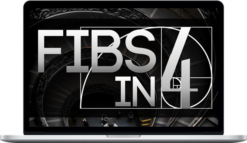Amon & Christina – Stock Market Investing for Financial Independence & Retiring Early
$175.00 $9.00
»Instant Delivery
Description
Amon & Christina – Stock Market Investing for Financial Independence & Retiring Early
This course consists of more than four hours of video instruction, more than thirty resources, and a 19-page downloadable pdf investment plan for you to fill out and create based on the information you learn from the course.
The video instruction is broken into twenty-one modules. Each module focuses on different investing topics, with the modules presented in sequential order.
We begin the course by discussing the steps you should take before you begin investing. We also discuss how to calculate your FIRE number and how that number relates to your overall investment portfolio and your withdrawal strategy during retirement. We then share stock market history information, historical market perspectives, and the mentality behind investing.
We go over the different types of investment accounts that may be available to you (including tax-advantaged and non-tax advantaged accounts) and we discuss the various types of fees associated with different types of investments. We discuss the key characteristics to look for when picking a brokerage company and we walk you through how to open a brokerage account, how to fund the account, and how to set the account up for automatic investments.
We discuss how to structure your order of investing and the different types of investments that you can add to your portfolio (including index funds, ETFs, REITs, individual stocks, and bonds). We discuss the key factors you need to consider when deciding on your asset allocation. We walk you through how to research different types of investments and what to look for when you’re investing in different assets, such as index funds, ETFs, REITs, and individual stocks.
We discuss whether you should lump sum your money into your investments or whether you should dollar cost averaging. We also discuss how to rebalance your portfolio, common investing mistakes to avoid, and how to invest during a recession and bear markets.
At the end of the course, we put everything together so that you can take action and invest.
“When you invest, you’re buying a day you don’t have to work.”
What You’ll Learn In Stock Market Investing for Financial Independence & Retiring Early?
Module 1 – Introduction & Overview
- Welcome!
- Download your Stock Market Investing Plan for FIRE and start your course!
- Module 1 Assignment: Section I of Your Investment Plan
Module 2 – Steps to Take Before You Begin Investing
- Establishing an Emergency Fund
- Pay off High Interest Debt
- Module 2: Summary Notes
Module 3 – Starting With a Goal & Achieving FIRE
- Calculating Your FIRE Number
- The Trinity Study
- Module 3: Summary Notes
- Module 3: Assignment #1 (Start With a Goal)
Module 4 – Stock Market History (Good Investors Know their History)
- How it All Began
- Crash of 1929 (Black Tuesday)
- Crash of 1973-74 (Oil Crisis Crash)
- Crash of 1987 (Black Monday)
- Crash of 2000 (Dot-com Bubble)
- Crash of 2008 (Great Recession)
- Crash of 2020 (Coronavirus Crash)
- Module 4: Summary Notes
Module 5 – Investing Mentality
- Controlling Your Emotions
- How to Behave During a Crash
- Module 5 Summary Notes
- Module 5: Assignment #1 (Investing Assessment)
Module 6 – Overview of Investment Accounts
- Two Types of Accounts: Tax Advantage & Non-Tax Advantage
- Tax Advantaged Accounts – 401(k)
- Tax Advantaged Accounts – Solo 401(k)
- Tax Advantaged Accounts – 457 Plan
- Tax Advantaged Accounts – Traditional IRA
- Tax Advantaged Accounts – 403(b)
- Tax Advantaged Accounts – Roth IRA
- Tax Advantaged Accounts – Self-Directed IRA
- Tax Advantaged Accounts – Health Savings Account (HSA)
- Tax Advantaged Accounts – 529
- Non-Tax Advantaged Accounts – Ordinary brokerage account
- Module 6: Summary Notes
- Module 6: Additional Resources
Module 7 – Types of Investment Fees
- Brokerage Fees
- Transaction Fees
- Expense Ratios
- Fronted-End Load Fees
- Back-End Load Fees
- Management Fees
- Annual Fees
- Impact of Fees
- Avoiding or Reducing Fees (Tip 1)
- Avoiding or Reducing Fees (Tip 2)
- Avoiding or Reducing Fees (Tip 3)
- Avoiding or Reducing Fees (Tip 4)
- Module 7: Summary Notes
Module 8 – Picking a Brokerage Company
- Evaluating the Brokers Security
- Insurance – What to Look For?
- Consider the Brokerages Fraud Policies
- Checking for Fees
- Assessing Customer Service
- Platform Interface (Website and App)
- Types of Accounts Offered
- Customer Reviews
- Module 8: Summary Notes
Module 9 – Opening A Brokerage Account
- Step-by-Step Instructions
- Module 9: Summary Notes
Module 10 – Funding Your Brokerage Account
- Options for Funding Your Account
- Module 10: Summary Notes
Module 11 – Automate Investments
- Automating – Benefit 1
- Automating – Benefit 2
- Automating – Benefit 3
- Automating – Benefit 4
- Setting Up Automated Investments
- Module 11: Summary Notes
Module 12 – Order of Investing
- Why Order of Investing Matters
- Step 1
- Step 2
- Step 3
- Step 4
- Step 5
- Step 6
- Step 7
- Bonus Step for Early Retirees
- Module: 12 Summary Notes
- Module 12: Assignment #1 (Your Order of Investing)
- Module 12: Additional Resources (How We Invested for FIRE)
Module 13 – Types of Investments
- Actively Managed Mutual Funds
- Index Funds
- Deciding Between Mutual Funds & Index Funds
- Mutual Funds vs. Index Funds – Goals & Fees
- Mutual Funds vs. Index Funds – Comparing Performance
- Index Fund Preference
- Exchange Traded Funds
- Comparison – ETFs and Index Funds
- Why People Choose ETFs Over Index Funds – Reason #1
- Why People Choose ETFs Over Index Funds – Reason #2
- Why People Choose ETFs Over Index Funds – Reason #3
- Why People Choose Index Funds Over ETFs – Reason #1
- Why People Choose Index Funds Over ETFs – Reason #2
- REITs
- Individual Stocks
- Bonds
- Module 13 Summary Notes
Module 14 – Asset Allocation & Optimal Returns
- What Is Asset Allocation
- Asset Allocation and Time Horizon
- Aggressive vs Reckless Investing
- Role of Bonds
- Stock vs Bond Allocation
- Problem With the Rule of Thumb
- Our Thoughts When Developing Our Portfolio Allocation
- Asset Allocation and Revisiting the Trinity Study
- See Inside Our Portfolio – Stocks Bonds and Emergency Funds
- See Inside Our Portfolio – Creating Our Core Investment
- See Inside Our Portfolio – Supporting Our Core Investment With ETFs
- See Inside Our Portfolio – Supporting Our Core Investment with REITs
- See Inside Our Portfolio – Supporting Our Core Investment With Individual Stocks
- Module 14: Summary Notes
- Module 14: Assignment #1 (Your Targeted Asset Allocation)
- Module 14: Additional Resources
Module 15 – Researching Investments
- Researching Investments in General
- Researching Index Funds
- Comparing Index Funds
- Researching and Comparing ETFs
- Researching and Comparing REITs
- Individual Stocks A Word of Warning
- Researching and Picking Stocks – Factor 1
- Researching and Picking Stocks – Factor 2
- Researching and Picking Stocks – Factor 3
- Researching and Picking Stocks – Factor 4
- Researching and Picking Stocks – Factor 5
- Researching and Picking Stocks – Factor 6
- Researching and Picking Stocks – Factor 7
- Module 15: Summary Notes
- Module 15: Assignment #1 (Your Investments)
Module 16 – Lump Sum Investing v. Dollar Cost Averaging
- An Identified Lump Sum
- Vanguard Study and Results
- The Mindset Role
- Taking Into Account the Fear of Investing
- The Ultimate Question to Ask Yourself
- Module 16: Summary Notes
- Module 16: Additional Resources
Module 17 – Rebalancing
- Strategy of Rebalancing
- Sample Portfolio to Rebalance
- Rebalancing Strategy #1
- Rebalancing to Reduce Risk
- Rebalancing to Increase Returns
- Rebalancing Strategy #2
- Rebalancing vs. Timing the Market
- Rebalancing Frequency Option #1
- Rebalancing Frequency Option #2
- Module 17: Summary Notes
- Module 17: Assignment #1 (Rebalancing Strategy)
Module 18 – Investing Mistakes to Avoid
- Eight Mistakes – Your Guiding Light
- Mistake #1
- Mistake #2
- Mistake #3
- Mistake 4#
- Mistake #5
- Mistake #6
- Mistake #7
- Mistake #8
- Module 18: Summary Notes
- Module 18: Assignment #1 (Note to Self – Investment Mistakes to Avoid)
Module 19 – Dealing With Recessions and Bear Markets
- Tip 1
- Tip 2
- Tip 3
- Tip 4
- Module 19: Summary Notes
- Module 19: Assignment #1 (Your Plan for Dealing with Crashes)
Module 20 – Putting it All Together
- Putting It All Together
- Module 20 Summary Notes
Module 21 – Continue Education
- Continuing Education
- Module 21: Summary Notes
- Module 21: Assignment #1 (Other Considerations)
More courses from the same author: Amon & Christina
Delivery Policy
When will I receive my course?
You will receive a link to download your course immediately or within 1 to 21 days. It depends on the product you buy, so please read the short description of the product carefully before making a purchase.
How is my course delivered?
We share courses through Google Drive, so once your order is complete, you'll receive an invitation to view the course in your email.
To avoid any delay in delivery, please provide a Google mail and enter your email address correctly in the Checkout Page.
In case you submit a wrong email address, please contact us to resend the course to the correct email.
How do I check status of my order?
Please log in to TradingAZ account then go to Order Page. You will find all your orders includes number, date, status and total price.
If the status is Processing: Your course is being uploaded. Please be patient and wait for us to complete your order. If your order has multiple courses and one of them has not been updated with the download link, the status of the order is also Processing.
If the status is Completed: Your course is ready for immediate download. Click "VIEW" to view details and download the course.
Where can I find my course?
Once your order is complete, a link to download the course will automatically be sent to your email.
You can also get the download link by logging into your TradingAZ account then going to Downloads Page.







